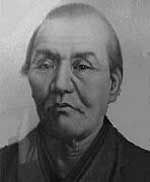 The films make Jirocho of Shimizu an undefeatable super-swordsman rushing to the aid of the innocent, assisting good gambling bosses against incursions of evil gambling bosses, & avenging wrongful deaths. The films make Jirocho of Shimizu an undefeatable super-swordsman rushing to the aid of the innocent, assisting good gambling bosses against incursions of evil gambling bosses, & avenging wrongful deaths.
History's actual Jirocho (his portrait heads this page, with another photo of his sour puss by the present paragraph) became known in his lifetime as "The Number One Boss of the Tokaido Highway," one of the main roads along which gangs operated after being expelled from Edo.
Born of the merchant class, he had become a common gambler, but one of such charisma, fencing ability, & leadership capacity that he rose swiftly through the underworld's ritualized system of advancement.
Magistrates & rival gangs fought him every inch upward. But eventually he became a respectable lawkeeper, though his "magistrate" post was only quasi-official.
He retired to Shimizu where he was a notable citizen involved in local government, taught swordsmanship, & lived to the ripe old age of 74.
He is a perfect example of how the likes of the legendary Chuji Kunisada really could exist, though of course Jirocho by right out outliving an era was able in later life to contribute to his own legend.
There's plenty of reason to believe he didn't exaggerate much, though. Late in his life, Jirocho was asked how it was he never lost a duel, & his answer was quite simple: "If someone was skillful enough to defeat me, I ran away."
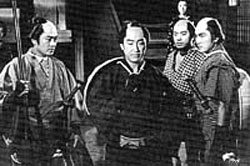 The great jidai-geki director Masahiro Makino made more films about Jirocho than any other single director.
The great jidai-geki director Masahiro Makino made more films about Jirocho than any other single director.
One of his series consisted of eleven films, constituting the Jirocho sangokushi series, made from 1952 to 1955. The films has been known in English both as "Travels of Jirocho" or "Jirocho the Mighty" series.
The "sangokushi" films beginning with Jirocho sangokkushi: Nagurikomi kojinyama (Jirocho's Tale of Three Provinces, 1952) were based on a novel by Genzo Murakami (1910-2006), who had films based on other of his books on Musashi Miyamoto's adversary Sasaki Kojiro, as well as the wandering shogun Mito-kimon, & others.
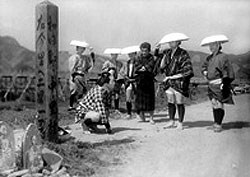 The first film of the series is included on the Kinema Jumpo List of the 100 Best Japanese Films right up there with films of Ozu, Mizoguchi, Kurosawa, & suchlike. The first film of the series is included on the Kinema Jumpo List of the 100 Best Japanese Films right up there with films of Ozu, Mizoguchi, Kurosawa, & suchlike.
In order of release, the eight follow-up films were Jirocho Sangokushi: Jirocho Hatsutabi (Jirocho's Tale of Three Provinces 2: First Journey, 1953); Jirocho sangokushi: Jirocho to Ishimatasu (Jirocho's Tale of Three Provinces 3: Jirocho & Ishimatsu, 1953); Jirocho sangokushi: Seizoroi Shimizu minato (Jirocho's Tale of Three Provinces 4: All Gathered at Shimizu Harbor, 1953); Jirocho sangokushi: Nagurikomi koshuji (Jirocho's Tale of Three Provinces 5: Violence of the Koshu Road, 1953); & Jirocho sangokushi: Tabi garasu Jirocho ikka (Jirocho's Tale of Three Provinces 6: Jirocho's Family of Wanderers, 1953).
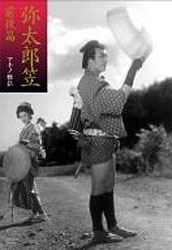 The series concluded the following year with Jirocho sangokushi: Hatsu iwai Shimizu minato (Jirocho's Tale of Three Provinces 7: First Celebration at Shimizu Harbor, 1954); Jirocho sangokushi: Kaito-ichi no abarenbo (Jirocho's Tale of Three Provinces 8: The Most Violent Men on the Road, 1954) avenging the death of Jirocho's lieutenant Ishimatsu; & Jirocho sangokushi: Kojinyama zenzen (Jirocho's Tale of Three Provinces 9: The Holy Mountain, 1954). The series concluded the following year with Jirocho sangokushi: Hatsu iwai Shimizu minato (Jirocho's Tale of Three Provinces 7: First Celebration at Shimizu Harbor, 1954); Jirocho sangokushi: Kaito-ichi no abarenbo (Jirocho's Tale of Three Provinces 8: The Most Violent Men on the Road, 1954) avenging the death of Jirocho's lieutenant Ishimatsu; & Jirocho sangokushi: Kojinyama zenzen (Jirocho's Tale of Three Provinces 9: The Holy Mountain, 1954).
The series starred Akio Kobori, & launched his acting career in 1952. His sincere visage makes him a precursor to the ninkyo or chivalrous yakuza stars of the '60s, such as Koji Tsuruta & Ken Takakura. He was also ahead of the vanguard among youth actors who started out mostly in the mid-1950s, but somehow he ended up surpassed by Kinnosuke Nakamura, Hashizo Okawa, Hiroki Matsukata & other youth actors who matured into timeless actors.
Despite recent revival of the entire nine-film series with fresh new prints (chambara fans at the 2008 Kyoto Film Festival celebrating 100 years of Japanese cinema, stayed up all night long for the whole series shown back-to-back until dawn). Even so, Akio Kobori is not today a well-remembered star. In the west, absurdly, he's known if for anything for his appearance in the flying-monster film Rodan (1956).
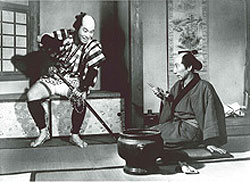 He reprised his role in another set of films, in which Jirocho is largely relegated to the background cast. The goofiest of his followers, Santaro, becomes the protagonist. He reprised his role in another set of films, in which Jirocho is largely relegated to the background cast. The goofiest of his followers, Santaro, becomes the protagonist.
These films from Toho Studios were Jirocho gaiden: Haikagura no Santaro (1957); Jirocho gaiden: Oabare Santaro gasa (1957); Jirocho gaiden: Oabare Jirochi ikka (1957); & Jirocho gaiden: Haikagura kiso no himatsuri (1958). Most Jirocho stories have at least a spark of humor, but Santaro's tales are over-the-top comedies.
These featured commedian Norihei Miki as Jirocho's follower Santaro, who is the three stooges roled up in one. He's shown here in a still wearing a stripped jacket which emphasizes his status as a clown. The word "gaiden" means "subsidiary tale" & several other gaiden about Jirocho's followers have been filmed.
copyright © by Paghat the Ratgirl
|
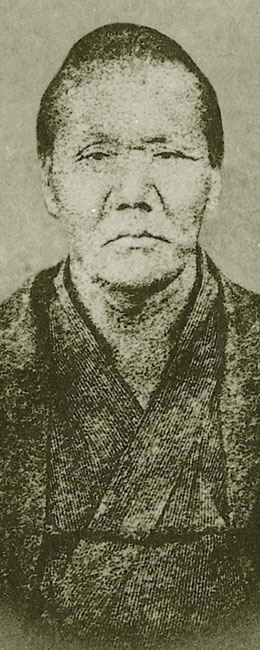


 The first film of the series is included on the Kinema Jumpo List of the 100 Best Japanese Films right up there with films of Ozu, Mizoguchi, Kurosawa, & suchlike.
The first film of the series is included on the Kinema Jumpo List of the 100 Best Japanese Films right up there with films of Ozu, Mizoguchi, Kurosawa, & suchlike. The series concluded the following year with Jirocho sangokushi: Hatsu iwai Shimizu minato (Jirocho's Tale of Three Provinces 7: First Celebration at Shimizu Harbor, 1954); Jirocho sangokushi: Kaito-ichi no abarenbo (Jirocho's Tale of Three Provinces 8: The Most Violent Men on the Road, 1954) avenging the death of Jirocho's lieutenant Ishimatsu; & Jirocho sangokushi: Kojinyama zenzen (Jirocho's Tale of Three Provinces 9: The Holy Mountain, 1954).
The series concluded the following year with Jirocho sangokushi: Hatsu iwai Shimizu minato (Jirocho's Tale of Three Provinces 7: First Celebration at Shimizu Harbor, 1954); Jirocho sangokushi: Kaito-ichi no abarenbo (Jirocho's Tale of Three Provinces 8: The Most Violent Men on the Road, 1954) avenging the death of Jirocho's lieutenant Ishimatsu; & Jirocho sangokushi: Kojinyama zenzen (Jirocho's Tale of Three Provinces 9: The Holy Mountain, 1954). He reprised his role in another set of films, in which Jirocho is largely relegated to the background cast. The goofiest of his followers, Santaro, becomes the protagonist.
He reprised his role in another set of films, in which Jirocho is largely relegated to the background cast. The goofiest of his followers, Santaro, becomes the protagonist.